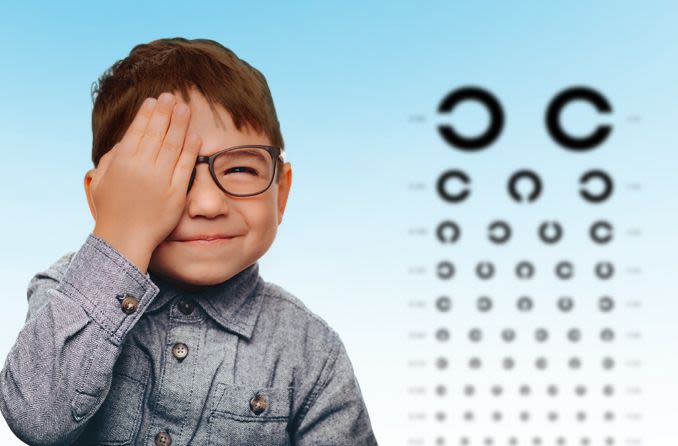
Help Your Child See Clearly with These Eye Health and Safety Tips
August is National Children’s Eye Health and Safety Month. This makes it the perfect time to look at some important ways to protect your child’s eyes and take care of them as they grow.
Most kids aren’t able to tell you when something is wrong with their eyes. This means parents need to be alert for signs that there is an issue.
The early years of your child’s development are crucial for their eye health. However, approximately one in 20 children between the ages of three and five experience a problem with their eyes.
Such issues need to be identified and treated quickly to ensure your child’s development remains on track and their long-term eye health isn’t negatively affected.
Why Childhood Eye Health is Essential
As a child develops, most of what they learn comes from sight. Seeing the world clearly helps children build skills like memory, reading, depth perception, and hand-eye coordination. It also helps your child’s confidence with gross motor skills like learning to walk.
Impaired vision can have a severe negative impact on these skills. This may lead to long-term consequences, such as developmental delays or learning difficulties.
Common Childhood Eye Conditions
Children’s eyes can be very sensitive. This is especially true when they are young, between the ages of three and five.
A wide variety of conditions can affect children in this age group. However, most preschoolers don’t receive a routine eye screening or exam (although they should). Once again, this leaves it up to parents to spot problems.
The most common signs of a childhood eye problem include:
-
Frequent rubbing of the eyes
-
Squinting
-
Turning or tilting the head
-
Squeezing the eyes
-
Excess eye watering
-
Difficulty with close-up tasks (playing, reading, coloring, etc.)
-
Droopy eyelid(s)
-
Closing one eye to try and see better
While these signs can be attributed to many different conditions, young children are affected by a handful more frequently than others.
A few of the most common childhood eye conditions are:
-
Short-sightedness (Myopia): Blurriness or difficulty while looking at things that are far away.
-
Lazy eye (Amblyopia): Poor vision in one eye that tends to move separately from the other. Classified as a brain disorder and is usually the result of a developmental vision issue that goes untreated.
-
Eye injuries: Children can injure their eyes in many ways. We’ll look at some examples later.
-
Crossed Eyes (Strabismus): An eye that turns inward or outward while the other is focused. This can lead to amblyopia.
-
Blindness: Inability to see. A child may or may not be able to see light depending on the severity.
Don’t Look at the Sun
Exposure to the sun’s harmful UV rays can quickly cause damage to the eye. Parents need to make their children wear sunglasses when spending time outdoors on sunny days.
Unprotected eyes can sustain serious damage from the sun. Even a few hours in bright sunlight without proper eye protection can lead to a sunburn on your eyes. This is incredibly painful and could negatively impact your child’s vision for several days to weeks. Over time, too much exposure to UV light can lead to problems like cataracts, macular degeneration, and even cancer.
Protecting your child’s eyes from the sun while they are young sets them up for a life of healthy vision as they grow older.
Keep Your Eyes on the Ball
According to the Consumer Health Digest, about 33,000 children under 16 suffer a sports-related eye injury each day. That is a massive number. Fortunately, most of those injuries can be prevented with proper equipment.
Protective eyewear is the most important. This is especially true for sports with balls being thrown or kicked as they can cause serious damage to your eyes.
If your child wears glasses already, be sure their lenses are made from shatterproof material like polycarbonate. If your child does get hit by a ball while playing their favorite sport, their lenses won’t shatter and send glass into their eye. Glasses designed for sports also offer protection for the eye itself by shielding it from dirt, stray fingers, and other objects that can cause damage.
Velocity Urgent Care is Ready to Help
By looking out for signs of eye problems in your child, you’ll know when it’s time to seek care. If taking steps to protect your child’s eyes isn’t enough and they do sustain an eye injury, Velocity Urgent Care is ready to help.
Our skilled and friendly providers will perform a thorough exam to determine what’s causing your child’s eye problems. From there, we can prescribe treatment as appropriate or refer you to a specialist within the Sentara Healthcare network for more specific care.
We offer convenient online registration that helps you limit your contact with others during your visit. You can sign up for an appointment online to skip the waiting room and arrive when it’s your turn to be seen.
Velocity Urgent Care even offers text message updates so you can wait in the car (if you prefer) until it’s time for your appointment.
In light of the COVID-19 pandemic, we are taking serious safety precautions to ensure that our locations are as clean as possible. We’ve put strict sterilization protocols into place and are carefully handling patients who may be contagious to ensure that each one of our clinics is safe for those who need urgent medical care or occupational health services.
Velocity Urgent Care is an in-network provider for most major insurance plans, meaning you can be seen for the cost of your co-pay and deductible.
All our locations also accept Medicare, Medicaid, and Tricare. Veterans Administration beneficiaries are also welcome.
Loading Conversation
